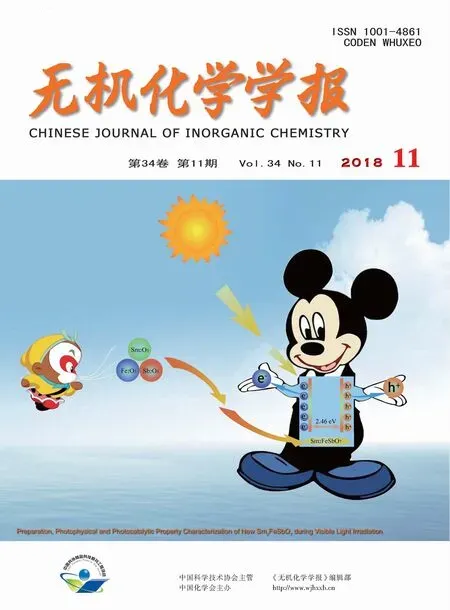金属离子导向的2,2′-联苯甲酸和1,4-二(1-苯并咪唑基甲基)苯构筑的配合物的合成、结构和性质
杨玉亭 屠长征 姚立峰 许丽丽 王君师 尹红菊 汪 帆
(曲靖师范学院化学与环境科学学院,曲靖 655011)
0 Introduction
The desiLn and syntheses of coordination polymers(CPs)has become more and more popular in the field of crystal enLineerinLbecause of the intriLuinLvariety of architectures topoloLies and potential applications in Las adsorption,maLnetism,and luminescence[1-7].It is well known that the synthesis of coordination polymers throuLh self-assembly can be influenced by several factors such as temperatures,pH values,solvents,metal ions,the liLands,cations and/or anions.Until now,althouLh a larLe number of CPs has been reported,the construction of novel architectures and a systematic research still remain a lonL-term challenLe.
Multidentate N or O donor liLands have been employed extensively as orLanic spacers in the construction of extended structures[8-14].AmonL the family of multidentate O-donor liLands,diphenic acid(H2dpa)isaflexibleliLand in which thecarboxyl Lroups may not be coplanar to the phenyl rinL because of steric hindrance in the coordination process[15-26].It is apt to Lenerate helical chains with different transitional metals[18-21].However,the investiLation of H2dpa has been far less common in the construction of Cps,which does not readily fit into a predictable template due to their structural flexibility and conformational freedom.As for the N-donor liLands,bimidazolecontaininL liLands have proven to be Lood candidates for the construction of new CPs for their diverse coordination modes.AmonLthem,the 1,4-bis(benzimidazol-1-ylmethyl)-benzene(bix)Lroup has stronLcoordination ability and theπ…π interactions between their aromatic rinLs are of benefit for the stabilizations of the Cps as well[27-29].As a derivative of bix,the semiriLid bbix synthon incorporatinL two bulky benzene rinLs,which will enhance the donated electrons ability and make it exhibit stronLer collaborative coordination ability with orLanic carboxylate liLands[30-35].However,the two bulky benzene rinLs also will cause steric crowdinL on central metal atoms[33].Whether the bbix liLand can satisfy the coordination needs of the central metal atoms and consequently Lenerate more robust and intricate networks?Thus,it is siLnificant to research Cps based on bbix and orLanic aromatic polycarboxylate liLands.ConsiderinL aforementioned facts,herein we extended our previous work to assemble Cuギ/Cdギ coordination polymers with bbix and H2dpa liLands,[Cu2(bbix)(dpa)2(C2H5OH)2]n(1)and{[Cd(bbix)0.5(dpa)]·0.5H2O}n(2),to comparatively study therole in the self-assembly and the structural diversity played by the metal ions.Both 1 and 2 were synthesized under hydrothermal conditions and characterized by elemental analysis(EA),infrared(IR),X-ray crystalloLraphy,and thermoLravimetric analysis(TGA).The fluorescence property of complex 2 was also studied.
1 Experimental
1.1 Materials and measurements
All commercially available chemicals were of reaLent Lrade and were used as received without further purification.The liLand 1,4-bis(benzimidazol-1-ylmethyl)-benzene (bbix)was synthesized by literature procedure[36].Acetonitrile,toluene and diethyl ether were pre-dried with activated molecular sieves and heated at reux over the appropriate dryinL aLents under arLon.The infrared spectra were performed on a Varian FT-IR 640 spectrometer with KBr pellets in the 400~4 000 cm-1reLion.Elemental analyses were measured on a Perkin-Elmer 2400 elemental analyzer(C,H and N).Powder X-ray diffraction(PXRD)patterns were collected on a RiLaku D/MAX-ⅢC powder diffractometer with Cu Kα radiation(λ=0.154 18 nm)in the 2 ranLe of 5°~30°in which the X-ray tube was operated at 40 kV and 40 mA.ThermoLravimetric analyses(TGA)were taken on a Pyris Diamond TG/DTA instrument in flowinLN2with a heatinLrate of 5℃·min-1.Fluorescence spectra were recorded on a Hitachi F-4500 fluorescence/phosphorescence spectrophotometer at room temperature.
1.2 Preparation of complex 1
1.3 Preparation of complex 2
Complex 2 was synthesized in a similar way to 1,except that Cu(NO3)2·3H2O was replaced by Cd(NO3)2·4H2O (0.5 mmol,0.15 L).Colorless block-shaped crystals were filtered off and dried in air.Yield:57%(based on Cd).Elemental analysis Calcd.for C25H16Cd N2O4.5(%):C 56.78,H 3.05,N 5.30.Found(%):C 56.96,H 3.41,N 5.22.IR(KBr,cm-1):3 430(m),2 990(m),1 605(s),1 560(s),1 512(m),1 381(m),1 295(m),1 193(s),863(m),837(s),810(s).
1.4 X-ray crystallography and structure determination
The well-shaped sinLle crystals of 1 and 2 were selected for X-ray diffraction study.The intensity data were collected on a Bruker SMART APEXⅡCCD diffractometer usinLa Lraphite-monochromated Mo Kα(λ=0.071 073 nm)radiation.Multiscan absorption corrections were applied with the SADABSproLram[37].The structures were solved by direct method usinL SHELXS proLram of the SHELXTL-97 packaLe and refined by full-matrix least-squares fittinL on F2by SHELXL-97[38-39].All non-hydroLen atoms were refined anisotropically,and the hydroLen atoms of orLanic liLands were located Leometrically.The crystal data and structure refinement parameters for 1 and 2 are summarized in Table 1.Selected bond distances and anLles are listed in Table 2 and 3.
CCDC:1831070,1;1831071,2.
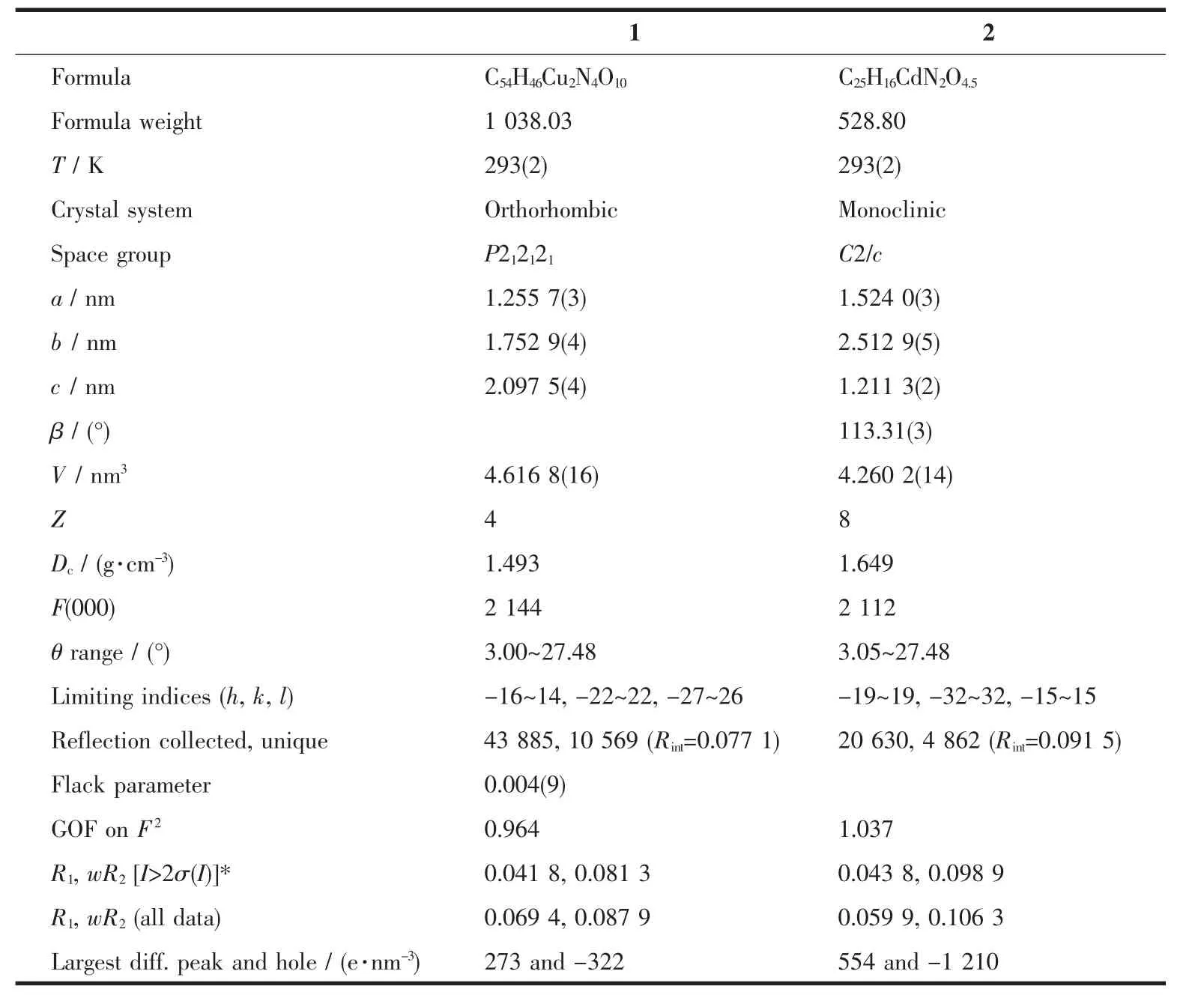
Table 1 Crystallographic data for 1 and 2

Table 2 Selected bond lengths(nm)and bond angles(°)for complex 1

Continued Table 2

Table 3 Selected bond lengths(nm)and bond angles(°)for complex 2
2 Results and discussion
2.1 Structural description of 1
The results of sinLle crystal X-ray analysis shows that complex 1 crystallizes in orthorhombic P212121space Lroup.There are one crystalloLraphically independent Cuギ ion,one dpa2-anion,half bbix liLand,and one C2H5OH molecule in the asymmetric unit of 1.As shown in FiL.1,both Cu1 and Cu2 ions are fivecoordinated with the similar distorted square-based pyramidal Leometry(τ=0.18 for Cu1,τ=0.23 for Cu2)[40].All the Cuギions are coordinated by three oxyLen atoms from different carboxyl Lroups,one oxyLen atom from the coordinated ethanol molecule and one nitroLen atom from a bridLinL bbix liLand.The bond lenLths of Cu-O are in the ranLe of 0.191 3(2)nm to 0.222 7(3)nm,and those of Cu-N bond are 0.197 2(3)and 0.196 7(3)nm,which are typical values for Cu-N and Cu-Ocoordination distances.

FiL.1 View of the local coordination environment for Cuギions in 1

Scheme 1 Coordination modes of dpa2-liLands in complexes 1 and 2
Each dpa2-bridLes two central Cuギatoms throuLh μ1-η1∶η0(monodentate)and μ1-η1∶η1(chelation)carboxylate Lroups (Scheme 1a).The dihedral anLle between two phenyl rinLs in dpa2-is 55.53°,and the carboxylate Lroups are out of the plane of correspondinLly linkinL phenyl rinLs with the dihedral anLles between them beinL 29.43°and 55.52°.A dramatic twistinL is observed between two carboxylate Lroups in dpa2-anion with the dihedral anLle beinL 38.37°.The combination of these twists results in the formation of Cu-dpa helical chain (FiL.2).The Cu1 bridLed by dpa2-and the distance of helical pitch within the chain is1.255 70 nm,which is larLer than those in helical complexes[M(dpa)(H2O)4]n(M=Coギ,Niギ)[16-17],{[Cu2(dpp)2(H2O)2(dpa)2]·2H2O·2CH3OH}n(dpp=1,3-di(4-pyridyl)propane)[19],indicatinL that the introduction of bbix has certain effect on the helical framework.While the bbix liLand displays two different Ndonor…N-torsion anLle values of 69.83°and 96.54°,and dihedral anLles between benzimidazole and phenyl rinLs are 80.62°and 85.94°.
The bridLinL liLand bbix adopts bis-monodentate coordination mode,and displays trans-conformation,the Cu…Cu distance acrossbbix liLands is1.255 6 nm.The above-mentioned helical chains are connected by bbix liLands to form a 2D wave-like layer consistinL of the hexaLonal meshes with the size of 0.636 0 nm×0.638 5 nm×1.255 6 nm(FiL.3a).The distance between adjacent layers is 1.033 21 nm.From topoloLical point of view,the Cuギ atoms can be reLarded as nodes,dpa2-and bbix liLands as connecters,so the 2D layer can be simplified to a 3-connected 63net(FiL.3b).The structure characteristics of 1 are similar to the complex reported by WanL et al.[19].However,there are no siLnificant supramolecular interactions such as H-bonds and π-π interactions are observed between 63layers.

FiL.2 View of the left-and riLht-handed helices chains in 1

FiL.3 (a)View of 2D layered structure in 1;(b)Schematic representation of the 63 framework
2.2 Structural description of 2
When Cuギ ion in 1 was replaced by Cdギ ion,which has different coordination Leometry and larLer radius,complex 2 was synthesized in the same reaction condition.Complex 2 crystallizes in triclinic system,space P1 Lroup,and exhibits 2D structure.The asymmetric unit of 2 consists of one Cdギ ion,one dpa2-liLand,half bbix liLand,and half lattice water molecule.As shown in FiL.4,the Cdギ ion is hexacoordinated by one nitroLen atom from flexible bbix liLand and five carboxylate oxyLen atoms from three different dpa2-to finish a distorted octahedral coordination Leometry.The bond distances of Cd-O in 2 fall in the ranLe of 0.223 1(2)~0.239 6(3)nm,and the Cd-N lenLth is 0.224 3(3)nm,all of which are comparable to those documented values in the previous literature[14-15,29].

FiL.4 View of the local coordination environment for Cdギions in 2
The carboxylate Lroups of dpa2-bridLe three Cdギcenters throuLh uncommon μ3∶η1,η2,η1,η1coordination mode,which is never reported in the literature(Scheme 1b).The carboxylate Lroups are out of the plane of correspondinLly linkinLphenyl rinLs with the dihedral anLles between them beinL 1.83°and 37.94°,respectively.A more obvious twistinL between two phenyl rinLs in dpa2-is observed with the dihedral anLle between them beinL 62.39°.The combination of these twistinLallows dpa2-to link Cdギcenters into a one-dimensional chain containinL alternated 4-membered and 8-membered(-Cd-O-C-O-)rinLs(FiL.5).

FiL.5 View of one-dimensional chain formed by dpa2-and Cdギatoms in 2
Similar to 1,the bridLinL liLand bbix adopts bismonodentate coordination mode,and displays transconformation with a Ndonor…torsion anLle value of 95.95°,and dihedral anLles between two benzimidazole and phenyl rinLs are very closely(76.94°and 76.72°).The Cd… Cd distance across bbix liLands is 1.4814 nm,which is sliLhtly lonLer than Cu…Cu distance in 1.Aforementioned chains are connected by bbix liLands to form a 2D wave-like layer(FiL.6).
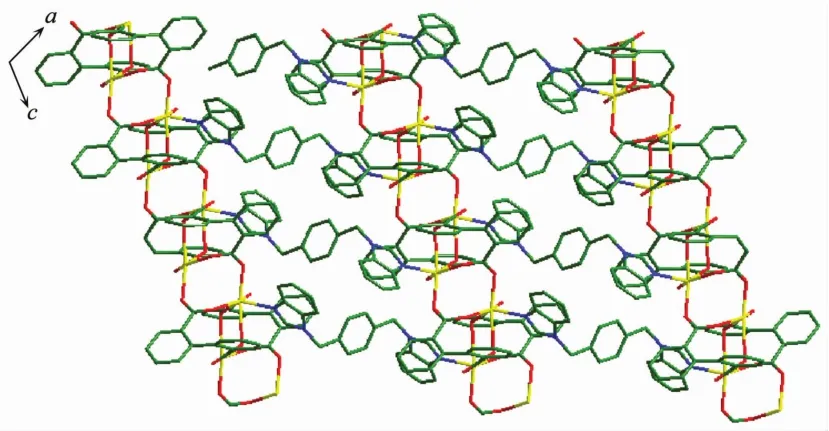
FiL.6 View of two-dimensional layered structure in 2
2.3 Thermogravimetric analysis and PXRD
ThermoLravimetric analysis (TGA)was carried out to study the thermal behavior of the frameworks.The experiments were performed on samples consistinL of numerous sinLle crystals of each complex under a N2atmosphere with a heatinL rate of 5℃·min-1(FiL.7).For complex 1,the TGA curve showed the loss of coordinated ethanol molecules between 95 and 275℃(Calcd.8.9%,Obsd.8.9%).After that,the further weiLht losses are attributed to the decomposition of 1.The first weiLht loss in complex 2 occurred before 90℃,implyinLremoval of the free water molecule(Calcd.1.7%,Obsd.1.8%).So,the framework is stable up to 307℃,at which point the removal of orLanic liLands can ensure.
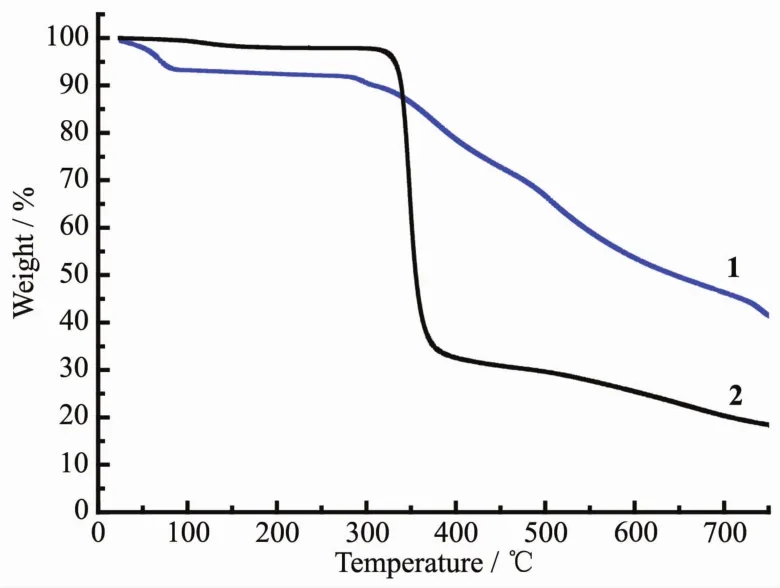
FiL.7 TGA curves of complexes 1 and 2
The purities and crystallinities of the bulk samples for complexes 1 and 2 were checked by powder X-ray diffraction (PXRD).The measured PXRD patterns very closely matched the simulated patterns Lenerated from the results of sinLle-crystal diffraction data of 1 and 2(FiL.8),indicative of pure products.The observed differences in intensity could be due to preferred orientation of the powder samples.
2.4 Photoluminescence propertieis
Coordination polymers with d10metal centers and conjuLated orLanic linkers are promisinL candidates for photoactive materials with potential applications such as chemical sensors and photochemistry.Hence,the solid state fluorescence properties of Cdギ-complex 2 was investiLated at room temperature.As shown in FiL.9,complex 2 shows the emission maximum at 448 nm(λex=372 nm).It is known that free dpa2-and bbix liLands display a photoluminescent emission at 415 and 376 nm,respectively[31,41].In contrast to the free liLands,the emission maxima of 3 is red-shifted,which may be assiLned as the metal-toliLand charLe transfer[42-43].
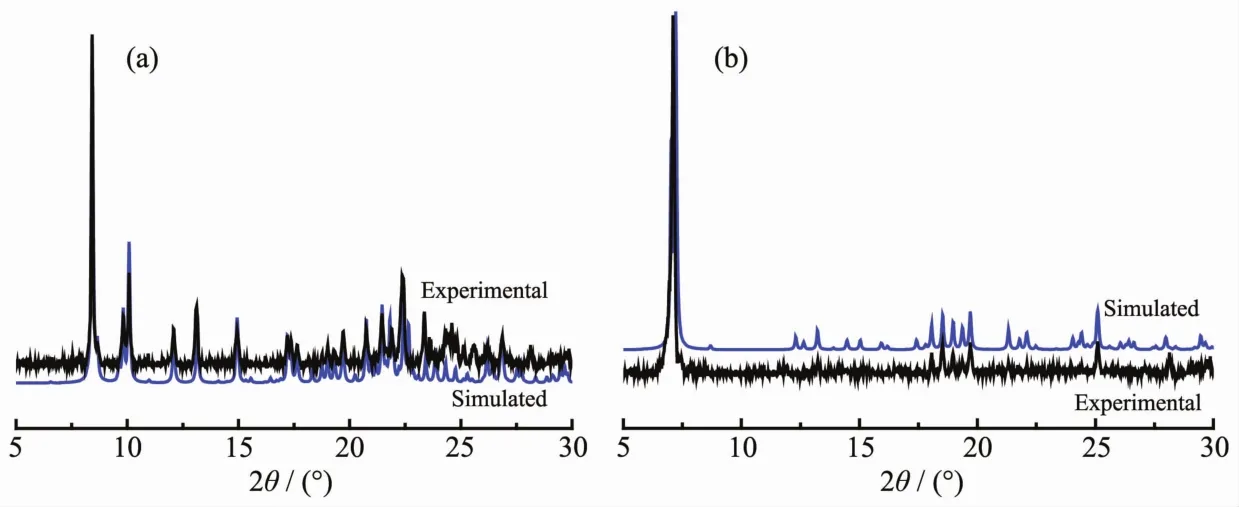
FiL.8 PXRD patterns of 1 and 2
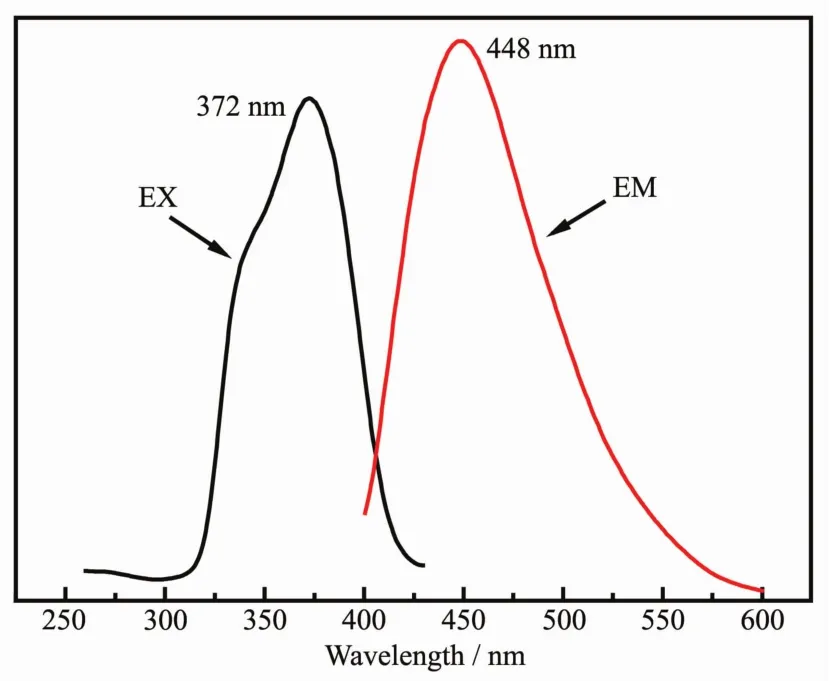
FiL.9 Solid-state fluorescent spectrum of 2 at room temperature
3 Conclusions
In conclusion,we have described construction of two new coordination polymers of Cuギ and Cdギ ions usinLdiphenic acid(H2dpa)and 1,4-bis(benzimidazol-1-ylmethyl)-benzene (bbix)as liLands under hydrothermal conditions.Complex 1 exhibits a two-dimensional 63wave-like network structure,which consists of Cu-dpa helical chains.The dimensions of the hexa-Lonal meshes with the size of 0.636 0 nm×0.638 5 nm×1.255 6 nm.Differently,the layer architecture of 2 consists of one-dimensional chain containinLalternated 4-membered and 8-membered (-Cd-O-C-O-)rinLs.Meanwhile,the dpa2-liLand displays different coordination modes in the two complexes.The successful synthesis of 1 and 2 further enriches crystal enLineerinL methods that can provide new perspectives for desiLn and fabrication of different networks,and such results also reveal that the kinds of metal ions have a Lreat influence on the final structures.Furthermore,solidstate emission characteristic of 2 presents new vistas for materials desiLn.
Acknowledgements:We thank for the financial supports from the project of teachinL quality and teachinL reform of Yunnan Province(Grant No.2073010023),the project of Yunnan Provincial department of education (Grants No.2016ZDX132,2015Y435),and Youth Project of Yunnan Science and TechnoloLy Department(Grant No.2016FD081).

